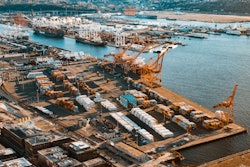
The United States ports-related components of the $1.2 trillion Infrastructure Investment and Jobs Act (IIJA), are front and center, given the heavy amount of attention being given to the ongoing supply chain challenges.
According to a White House fact sheet, the legislation invests $17 billion in port infrastructure and waterways and $25 billion in airports to address repair and maintenance backlogs, reduce congestion and emissions near ports and airports, and drive electrification and other low-carbon technologies.
Modern, resilient, and sustainable port, airport, and freight infrastructure will strengthen our supply chains and support U.S. competitiveness by removing bottlenecks and expediting commerce and reduce the environmental impact on neighboring communities.
U.S. Transportation Secretary Pete Buttigieg said that on the heels of President Biden signing the IIJA into law, it is now time to get to work on repairing the nation’s infrastructure.
“Decades of underinvestment in our supply chain infrastructure combined with unprecedented consumer demand, and the global pandemic all combined have put supply chains to the test,” he said. “We recognize that while supply chains are mainly in the private sector, there are moved that the Administration can and must take to help and are reflected in the President’s port action plan.”
Some examples of progress made to date by Buttigieg, included:
- working with the Georgia Ports Authority to provide flexibility for federal funds to create pop-up container yards in Georgia and North Carolina to transfer containers further inland via rail and truck and freeing up precious dock space at the port;
- a pending announcement in the next 25 days for $230 million in funding, for ports around the country, from the existing Port Infrastructure Development Grant Program; and
- in the next 90 days the next round of port grant funding will be issued, marking the first funds granted under IIJA
The White House released a fact sheet specific to ports with a “set of concrete steps to accelerate investment in our ports, waterways and freight networks,” with multiple goals and objectives, including: increasing federal flexibilities for port grants, accelerating port infrastructure grant awards, announcing new construction projects for coastal navigation, inland waterways, and land ports of entry, and launching the first round of expanded port infrastructure grants through IIJA.
With a sharp eye on the ongoing supply chain issues, the White House rolled out various port-related action items, including:
- allowing U.S. port authorities to redirect project cost savings toward tackling supply chain challenges, with the Biden-Harris Administration continuing to look for additional flexibilities and other solutions to support infrastructure needs in the goods movement supply chain;
- alleviating congestion at the Port of Savannah by funding the Georgia Port Authority pop-up container yards project. The Georgia Port Authority will be able to reallocate more than $8 million to convert existing inland facilities into five pop-up container yards in both Georgia and North Carolina and transfer containers via rail and truck further inland to be closer to their final destination, which will make available valuable real estate closer to the port. The effort will free up more dock space and speed goods flow in and out of the Port of Savannah, which leads the nation in containerized agricultural exports;
- launch programs to modernize ports and marine highways with more than $240 million in grant funding within the next 45 days. The Port Infrastructure Development Grant program is the first and only federal grant program wholly dedicated to investments in port infrastructure. DOT will award $230 million in funding for this program and $13 million for the Marine Highway Program to support waterborne freight service;
- identify projects for U.S. Army Corps of Engineers construction at coastal ports and inland waterways within the next 60 days. This plan will provide a roadmap for more than $4 billion in funding to repair outdated infrastructure and to deepen harbors for larger cargo ships;
- prioritize key ports of entry for modernization and expansion within the next 90 days. This plan will identify $3.4 billion in investments to upgrade obsolete inspection facilities and allow more efficient international trade through the northern and southern borders; and
- open competition for the first round of port infrastructure grants funded through the bipartisan infrastructure deal within 90 days. DOT will announce more than $475 million in additional funding for port and marine highway infrastructure
West Coast Ports Move to 24/7
According to our sister website Supply & Demand Chain Executive, The White House Briefing Room released a plan to reduce bottlenecks at major United States ports Los Angeles and Long Beach. After a year of ports and ocean freight making headlines for delays and disruptions, the industry is in need of a change and President Biden's new plan aims to reduce these issues. The plan includes the Port of Los Angeles joining the Port of Long Beach in increasing operation hours to 24/7, almost doubling hours that cargo is able to move out, along with numerous other contributions from major companies. Some experts feel that this a good short term solution but will need an impressive number of new workers during a major employee shortage. The jury is out on whether or not this will be a long term fix. The plan comes in time for the holiday season, which is expected to start earlier and cause even more delays in the supply chain.
Per the White House Briefing Room:
- The International Longshore and Warehouse Union (ILWU) announced its members are willing to work those extra shifts. This will add needed capacity to put towards clearing existing backlogs. This is an important first step, now the private businesses along the supply chain need to move their operations to 24/7.
- Large companies are announcing they will use expanded hours to move more cargo off the docks, so ships can come to shore faster. Unlike leading ports around the world, U.S. ports have failed to realize the full possibility offered by operation on nights and weekends.
- The commitments being announced today include:
- The nation’s largest retailer, Walmart, is committing to increase its use of night-time hours significantly and projects they could increase throughput by as much as 50% over the next several weeks.
- UPS is committing to an increased use of 24/7 operations and enhanced data sharing with the ports, which could allow it to move up to 20 percent more containers from the ports.
- FedEx is committing to work to combine an increase in night time hours with changes to trucking and rail use to increase the volume of containers it will move from the ports. Once these changes are in place, they could double the volume of cargo they can move out of the ports at night.
- Samsung is committing to move nearly 60% more containers out of these ports by operating 24/7 through the next 90 days. 72% of U.S. homes have at least one Samsung product, from appliances to consumer electronics.
- The Home Depot is committing to move up to 10% additional containers per week during the newly available off-peak port hours at the Ports of L.A. and Long Beach.
- Target, which is currently moving about 50 percent of its containers at night, has committed to increasing that amount by 10 percent during the next 90 days to help ease congestion at the ports.
- Across these six companies over 3,500 additional containers per week will move at night through the end of the year.
Since the announcement, the port has generally operated about 19 hours a day, with flex hours implemented when the cargo surge began. Buttigieg said that the recent reduction in containers lingering at the Port of Los Angeles marks an "early but a very promising sign" that efforts by port officials and the Biden administration to mitigate cargo backlogs are working.




















